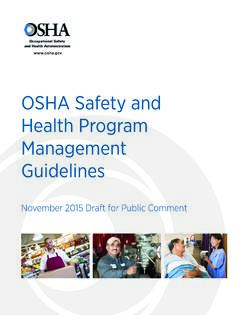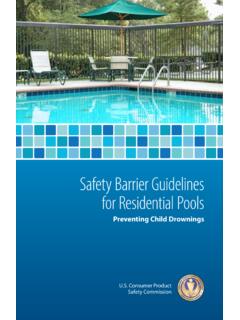Transcription of Injury Statistics and Safety Guidelines for Ladders
1 Injury Statistics and Safety Guidelines for Ladders By Hilario Garcia Loss Control Consultant Western Growers Insurance Services Ladders are tools. Many of the basic Safety rules that apply most tools also apply to the safe use of Ladders . Just like any tool, Ladders present the risk for falls if they are not used properly or if they are not in good condition. Ladder Injury Statistics A Consumer Product Safety Commission (CPSC) report on ladder Safety showed some eye opening Statistics regarding the frequency and severity of ladder-related incidents in the United States. Every year, thousands of people are injured and hundreds are killed in ladder-related incidents. Determining the root cause of these incidents can lead to the prevention of the majority of injuries and deaths. More than 90,000 people receive emergency room treatment from ladder-related injuries per year. Elevated falls account for almost 700 occupational deaths annually.
2 These deaths account for 15% of all occupational deaths. OSHA believes 100% of all ladder incidents could be prevented if proper attention to equipment and climber training were provided. Over the last 10 years, the amount of ladder-related injuries has increased by 50%. According to the Bureau of Labor Statistics (BLS), 50% of ladder-related incidents were due to individuals carrying items as they climbed a ladder. The most common type of ladder-related Injury is a fracture, at 32% of all incidents. Guidelines for Safe Ladder Use Following Safety Guidelines and implementing a ladder policy can help in the prevention of ladder-related incidents. The following are several Safety measures to keep in mind for ladder usage: Choose the appropriate type and size of ladder for the job. Inspect Ladders at the start of each shift for cracks, breaks, loose/missing rivets or bent parts.
3 Tag and remove defective Ladders from the workplace for repairs or replacement. Never stand on the top 3 rungs. Paint the 3rd rung from the top red as a reminder. Face the ladder when ascending or descending while using three points of contact at all times. Keep belt buckle, tool bag, or picking bag centered between outer rails of the ladder and do not over reach while working. Do not walk the ladder. Climb down to reposition the ladder when needed. Set the ladder on solid and level footing. To avoid slipping, wear work boots with heels (not sneakers) and keep outer soles free from mud, oil, or grease. Do not jump from Ladders . Always use the bottom rung. Only one person at a time is allowed on a ladder. Place the base of a straight ladder out away from the wall or edge about one foot for every four feet of vertical height. Be sure the side rails extend at least 36 inches above the landing.
4 For orchard Ladders , place the 3rd leg outward, far enough so the steps are level and the 3rd leg is centered between the two side rails. For ladder Safety awareness, review the company s ladder policy in place and review ladder use Guidelines to all workers utilizing this tool. Ensuring that all workers follow safe work practices while performing their duties through the course of periodic audits and observations. Additional resources for safe ladder use can be obtain from OSHA, 3625 -02R 2014, Falling Off Ladders Can Kill or by contacting your insurance provider.








